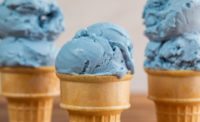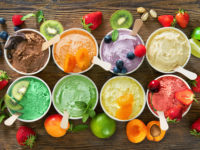Dairy products find natural hues
Dairy processors continue to seek out clean-label coloring options, but they come with some challenges.

Photo courtesy of DDW

Photo courtesy of Flavorchem

Photo courtesy of GNT USA



It is said that we eat with our eyes first — just look at any cooking competition show’s focus on a dish’s presentation. And one of the first things to notice about food’s appearance is its color.
“Color is critical to the way consumers experience food, often associated with taste and quality,” explains Rebecca Shurhay, marketing analyst for Downers Grove, Ill.-based Flavorchem.
However, not all paths to creating vibrant hues in dairy products are created equal. Label-conscious consumers tend to prefer naturally derived coloring options; however, they still want a product to be the bright shade they’d expect.
“Consumers today want to ‘have their cake and eat it too,’” says Stephen Lauro, general manager for Anaheim, Calif.-based colorMaker Inc. “Consumers want bright, vibrant colors derived from sustainable, all-natural sources that improve the visual appearance of foods and beverages.”
And to win with today’s shoppers, dairy processors need to find the harmony “between a color’s overall appearance and formulation performance,” notes Emina Goodman, senior director, commercial color development for Chicago-based ADM.
Trending hues
Color adds more than just visual appeal — it can be a signifier of a product’s healthfulness and nutritional qualities.
“Consumers are interested in both health-signaling and adventurous flavors and hues, and dairy processors’ color demands are reflecting this,” Goodman says.
She adds that she is seeing many requests for warm hues — including red, orange, yellow and pink — due to their health halo association with citrus and vitamin C. And adventurous eaters may be drawn to colors associated with global flavors such as turmeric (yellow) and ube (purple).
Social media’s visual focus has meant that many consumers are drawn to bright and bold food offerings that photograph well.
“Eye-catching and Instagram-worthy offerings like black or rainbow ice cream [are] also prompting more creativity from formulators as they look for new bright and rich stable color options,” Goodman remarks.
ADM’s blue offering could fit the bill here. The company offers “the industry’s only patented acid-, light- and heat-stable blue, which is created using the huito fruit from Peru’s Amazon region,” Goodman emphasizes. The color lends itself to creating “various stable shades of green, purple and brown” from a natural source.
According to Sanford “Sandy” Golden-Dukes, director of business development and operations for IFC Solutions, Linden, N.J., processors have been asking for more “artisanal” hues that pair with bold new flavors.
“So, greens, reds and blues are a big ask these days,” he points out.
Find a natural solution
After choosing an appropriate hue for their product, processors also need to consider if they should go with a natural approach to coloring it. And according to Goodman, “62% of consumers state they actively avoid artificial coloring in foods and beverages.”
Lawrence Blitz, president of Ventura, Calif.-based Green Source Organics, confirms that he’s mostly seeing requests for natural colors from his clients across the food and beverage industry.
The desire for natural colors fits into the broader movement toward clean-label products, which often means those made with recognizable ingredients and without synthetic components.
“As the trend in the market pushes for more natural and clean-label products, the need for natural color solutions is increasing for both consumers and dairy processors,” says Shurhay. “According to research from the International Food Information Council, four in 10 consumers identify as clean eaters —with around 66% of surveyed respondents paying more attention to food and beverage ingredient lists than they were a year ago.”
Jeannette O’Brien, vice president for Tarrytown, N.Y.-based GNT USA, says, “consumers are more concerned than ever” with where products come from and how they are made.
“This can be a determining factor in their decision to select one product over another,” she notes.
Brian Sethness, executive vice president, sales and marketing – Americas for Skokie, Ill.-based Sethness Roquette, adds, “Dairy consumers do not want to see any FD&C dyes in their products, so natural colors certainly are most appealing.”
However, Lauro notes that consumers expect products containing clean-label natural colors to still look like they’d imagine — for example, all-natural strawberry milk should still appear pink.
“Consumers are not interested in scientific lectures about the food safety benefits of thermal processing and the impact of such processing on natural colors,” he adds.
And some hues simply translate better to a natural formula than others, explains Connie Sandusky, global marketing director for DDW, Bethesda, Md.
“Yellows are a cinch,” she points out. “Compatible options in dairy include annatto, paprika, beta carotene and turmeric.”
O’Brien notes that bright blues and deep purples can also easily be produced naturally with “consumer-friendly ingredients such as carrots and spirulina.”
However, some other colors might be a little trickier, explains Andrew Kendrick, technology manager, Europe for DDW. For example, beetroot can give a product a warm pink hue, but it also requires processing order changes to limit its heating time exposure.
“Anthocyanins such as Amaize red or purple carrot offer a lovely red, but a pH adjustment may be needed to accommodate anthocyanins’ color shift,” he adds.
However, while some colors are more difficult to translate to a natural option, there should be a way to do it, say Kristy Ellenson, senior marketing specialist and market segment manager – foodservice, and Elijah Church, head of business unit colors, at Cartersville, Ga.-based Doehler North America.
“The progress we’ve made in developing a full color spectrum with natural color sources over the past decade is astounding,” they add. “While there is still an exception here and there, most hues can be achieved with the right color or combination of colors.”
Jeff Greaves, president of Food Ingredient Solutions, Teterboro, N.J., says now that spirulina has been approved for blue, most colors can be achieved naturally.
“For red, we typically use beet, lycopene dispersion and sometimes red radish. For yellow, we use yellow beet, annatto, beta-carotene, carrot color and turmeric,” he points out. “For orange, we use paprika, beta carotene, apocarotenal and blends. For blue, we use spirulina. For violet, a spirulina blend with the reds, and for green a spirulina blend with the yellows.”
Mind the order of operations
One challenge to working with natural colors is that processors need to consider their inclusion from the beginning of the research and development process, note Ellenson and Church.
“Each color has its own ‘personality,’ and therefore the ability to thrive is something that is determined by a careful and thoughtful approach to product development,” they explain. “If a product developer waits to consider color until the project is nearly complete, that is where [we] commonly see major challenges occur.”
Blitz emphasizes that there is inherently more of a trial-and-error process during the research and development phase if a manufacturer is moving toward a natural coloring option.
“The steps in which these ingredients are added to maintain the color is also an important factor which would happen typically at the formulation level,” he points out.
Part of this trial-and-error process involves looking for ingredients that will withstand harsh processing conditions such as pasteurization, explains Blitz. And sourcing clean-label ingredients that stand up to these demands can be a challenge.
“It’s very important to know which color sources are [affected] by the environmental situations they are put into,” Golden-Dukes remarks.
According to Lauro, due to processing conditions, some dairy products such as ice cream and cheese are easier to color naturally than others — such as ultra-high-temperature milk and yogurt.
“Natural colors can be greatly affected by the high heat common in processing methods like pasteurization or [methods] used to extend shelf life, which impacts intensity and stability of certain chromophores,” explains Goodman. “Additionally, high-acidic applications like yogurts and free calcium ions in milks and ice creams can affect pH levels, which in turn influence color stability.”
For its part, ADM offers Colors From Nature — a line of heat- and acid-stable colors that fit the bill.
High-heat conditions can be especially harmful to natural reds, explains Jody Renner-Nantz, applications manager, science and innovation, Americas, DDW.
“Red color is important in many dairy products such as yogurt, ice cream and [ready-to-drink] milk drinks,” she notes. “Red beet offers beautiful shades of pink to red, but because it will fade with heat, the processor has to overdose to accommodate for the loss during heating. With some systems, you can add the color nearer to the end of the heating process, but you have to make sure to pasteurize the color before adding.”
For high-heat processing situations, Golden-Dukes recommends “an anthocyanin-based color” instead of a beet-derived one.
Another common challenge when formulating with natural color is pH sensitivity, Renner-Nantz remarks.
“Some of the vegetable-sourced anthocyanins function fairly well in dairy systems, but you have to be very careful on the upper pH range, or the anthocyanins will degrade,” she says. “Carmine is still the gold standard for hue and stability, but it’s not suitable for products that need kosher certification.”
Lauro says warm hues do better in low-pH environments, and cool hues “prefer the neutral environment of milk.” Therefore, he recommends dairy processors get creative with other ways to color their products if there is a pH challenge in coloring them naturally.
“A fruit preparation (with an acidic pH) might be swirled through ice cream or placed at the bottom of the yogurt cup,” he points out. “Similarly, an inclusion might be mixed into ice cream or granola intended as a topping for yogurt.”
Another challenge is that some natural ingredients derived from fruit, vegetables and botanicals can impart odors that are at odds with the flavor of a product, Goodman remarks.
“For example, if an ice cream maker wants to create an orange [ice cream novelty], a great option for a natural orange color is paprika, but it has a strong, earthy smell and taste,” she adds. “Our extraction technology at ADM removes the earthy notes from paprika while also keeping its original color properties to achieve a bright orange color for a delicious and visually appealing frozen treat.”
Still a place for artificial
Sometimes, however, the best option for a manufacturer is to use an artificial color.
“Artificial colors would always be the better choice as a colorant unless you are looking specifically to make a ‘clean-label’ claim,” Golden-Dukes emphasizes.
To that end, Lauro notes that in some dairy processes such as aseptic packaging for ready-to-drink milk beverages, artificial colors “reign supreme.”
And Greaves says that if a brighter hue is desired, a synthetic color may still be a manufacturer’s best bet.
“Natural colors tend to be a bit more pastel in shade and not as neon as synthetic colors, so artificial colors might be needed for really bright novelty and children’s applications,” he explains.
Golden-Dukes agrees that artificial colors could be a better choice if a brighter hue is desired; they also are less costly to use and less susceptible to supply-chain disturbances.
“[This] has been the year of bad supply chain for all industries,” he adds. “So this can sometimes play a role in favor of FD&Cs compared to natural.”
Looking for a reprint of this article?
From high-res PDFs to custom plaques, order your copy today!






.jpg?height=200&t=1639062115&width=200)


